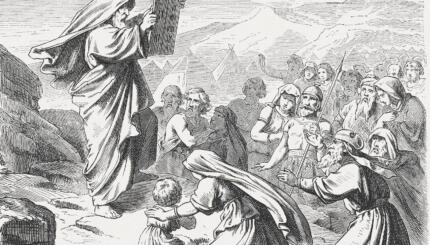The Torah books of Numbers and Deuteronomy recount how the Israelites captured territories east of the Jordan River which were later settled by the tribes of Reuben, Gad, and half of Manasseh. The Book of Joshua (in Prophets) then presents the “official” biblical version of the conquest and settlement of the Promised Land. The people of Israel, assembled on the eastern banks of the Jordan, were ready to cross the river and conquer the land of Canaan.
Joshua son of Nun, Moses’ successor, first sent spies and, encouraged by their report about the fear of the Canaanites, immediately decided to attack Jericho, the strongest town in the area. The miraculous fall of Jericho opened the road inland. Joshua led his people southward, then towards the hills of Judea, and later to the north, in a series of successful campaigns crowned by the conquest of Hazor — the strongest town in the north. The capture of Shechem is not mentioned, but the Bible states that once the conquest was completed, the people of Israel gathered there for a national assembly, an indication that Shechem was already in the hands of the tribes of Israel.
Discrepancies: Book of Joshua vs. Book of Judges
The historical validity of this account of the conquest is highly dubious. Analysis of other biblical texts reveals many discrepancies. The Book of Judges (also in Prophets) recounts separate campaigns by individual tribes; and, although it places the events after Joshua’s death, they constitute in fact a different version of the story of the conquest. The Book of Joshua describes a well‑organized campaign of a people united by a common national goal, while the Book of Judges reports many separate battles against Canaanite peoples waged by individual tribes or by temporary alliances of several tribes, enlarging their territories at the expense of their neighbors.
Furthermore, according to the Book of Joshua, the entire country was taken by the Israelites, while the Book of Judges reveals that one of the severe problems of the tribes was the constant struggle with Canaanite enclaves which successfully retained their independence.
Finally, in the period covered by the Book of Judges, the tribes were headed by local commanders (the “judges”), and there was no single national leader. The editor of the Book of Judges regarded this as a sign of social disintegration following the death of Joshua–divine punishment for lapses of idolatry. Modern scholars, however, believe that the state of anarchy reflected in the Book of Judges is closer to the true historical process of the colonization of Canaan.
Archaeological Findings
Finally, archeological research has found no traces of any sudden violent destruction of the major Canaanite towns. Jericho, for example, was clearly not destroyed in the time of Joshua. On the other hand, excavations reveal that many small settlements began emerging on the outskirts of the existing Canaanite towns, not in place of them. Dwelling structures and pottery typical of semi‑nomadic people indicate a long process of colonization rather than a short war of total conquest.
On the basis of such evidence, modern scholarship offers three basic theories concerning the conquest and settlement of the land. The first two accept in essence the historical truth of the Exodus story; one suggests two major waves of emigration from Egypt, reaching Canaan separately within several decades and occupying the land; the second theory proposes a continuous flow of migration from nomadic tribes from Egypt through Sinai, and also from Mesopotamia, which gathered around common religious centers, forged alliances in times of crisis, and eventually consolidated into one nation.
The third model is far more “Canaanite” and underplays the importance of foreign ethnic elements. According to this view, the nucleus of the nation of Israel was made up of slaves and oppressed people in Canaan who abandoned their masters and settled outside the towns. They were perhaps joined over the years by nomadic tribes from the Sinai desert, but these could not have been many. In any event, all of the oppressed elements combined to rise against their former lords and took over the land. In the process they evolved into a national society which invented for itself the tradition of a common past.
Reprinted with permission from A Historical Atlas of the Jewish People edited by Eli Barnavi and published by Schocken Books.
Torah
Pronunced: TORE-uh, Origin: Hebrew, the Five Books of Moses.



